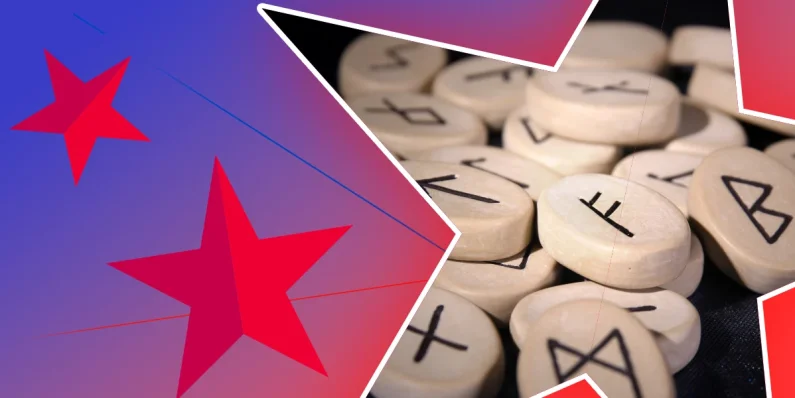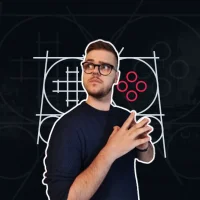
When Runes Run Amok - it's time to find another alphabet
You're making your way through a highly immersive pirate adventure. Over the last hour, you've progressed from a dark cargo hold, through a bustling tavern and the last couple puzzles on a tropical island is all that lies between you and the treasure you were promised.
You approach a faux-stone door, noting that it'll require a 5 letter combination. Your co-conspirators spot an oversized cipher wheel on the other wall. You'll need to find 5 symbols for them to decode, and they'll shout the letters for the door back to you.
But as you start to find the symbols, scrawled in ominous red paint, you're struck by a realization. You've seen them already. In Mayan ruins, the crypt, even a sci-fi room you visited a couple of years ago.
The voices of your teammates become distant as you desperately attempt to find an answer: why would a pirate king use a Germanic alphabet from the 6th century to hide his treasure?
Shooting yourself in the Futhark
Futhark (most often Elder Futhark) symbols have become a commonplace, theme-agnostic writing system to use in various escape room puzzles. Be it substitution ciphers, "call-and-response" cooperative puzzles or Simon Says style sequences, someone somewhere has slapped that set of symbols on it.
There is reasoning behind this, of course. Individual runes within the alphabet are quite distinct, allowing players to tell them apart in low light conditions or from afar. For "call-and-response" style puzzles, they offer an additional layer of challenge in having to describe them to the player inputting the combination.
Relaying the full combination with letters or numbers would be trivial, and shouting "5-3-4-1" or "M-H-K-P" across the room does not an enjoyable puzzle make.
But as very few players will know what the hell you mean by "ansuz-gebo-ehwaz-dagaz", you'll need to be more descriptive, instead indicating "the one that looks like an F" or "an hourglass on its side". It's great fun.
However, the use of Futhark brings problems with it as well, in that despite the attempts to use it in a theme-agnostic fashion - from Mayan temples to sci-fi spaceships - it's strongly associated with Germanic, Viking and potentially Slavic cultures. particularly early-Middle Ages. In a room without a thematic connection to these, the runes can stick out and not in a good way.
With more and more escape rooms going for a sense of internal diegetic consistency - objects in a room making sense to be there in the story - the use of the Germanic alphabet becomes a trade-off.
It sacrifices thematic consistency: a pirate king would not write clues down as Viking runes; for practicality: it makes for a good puzzle.
I'd argue it's a sacrifice that seldom needs to be made, as a plethora of other alphabets exist, offering comparable practical advantages and potentially a better thematic fit.
Rosicrucian, Templar or Pigpen Ciphers
https://www.dcode.fr/pigpen-cipher
https://www.dcode.fr/rosicrucian-cipher
https://www.dcode.fr/templars-cipher
Highly geometric, comprised mostly of dots and straight lines, these ciphers are thematically connected to Freemasonry and secretive monastic orders like the Knights Templar. They'll be a good fit for escape rooms going for a late-Middle Ages, Arthurian or secret society aesthetic.
The symbols in these alphabets are rather similar to each other, often differentiated only by facing or a single dot. This makes them less suited for a "call-and-response" type puzzle . But they make up for it by being perfect to use in a more tactile challenge - assembling the symbol out of puzzle pieces or in a sliding tile puzzle.
Agrippan Alphabets
https://www.dcode.fr/celestial-alphabet
https://www.dcode.fr/passing-river-alphabet
Originally found in Heinrich-Cornelius Agrippa's Book of Occult Philosophy, alphabets like "Passing of the River", "Malachim" or "Celestial Language" offer a large set of highly varied symbols with occult, alchemical or astronomical connotations.
An interesting facet is that many of these symbols have a variable number of small, hollow circles on their ends. This allows for a puzzle where they're overlaid over a map (star or land), a page of text or hung on small nails, adding another layer of challenge.
Chappe Code
https://www.dcode.fr/chappe-code
Based on the possible positions of the arms on a Chappe telegraph, this alphabet relies in large part on symbols differentiated by symmetry and asymmetry. While the symbols themselves are a bit boring, they allow for an interesting use of a mirror to turn one into another. Alternatively, they fit well into a "move a matchstick" type exercise. Even alternativelier, multicolored Chappe symbols can be combined to form a picture that will need to be separated to form a sequence.
Based on their simple, narrow shapes they'll fit right in a futuristic or urban aesthetic - both on a computer screen and as something an inmate could scratch onto a cell wall.
Lunar Alphabet
https://www.dcode.fr/lunar-alphabet-leandro-katz
Devised in 1978 by poet and artist Leandro Katz and exhibited in several museums around the world, the Lunar alphabet was used as a means of communication with director Jesse Lerner.
It consists of 27 photographs of moon phases, each corresponding to a letter. For use in a context where photographs don't make much sense, engravings or sketches could also be used. In a similar way, you could base a substitution cipher on any item that can go from full to empty, like a glass of liquid.
It differs from the preceding systems in that to find the right element to substitute, a player will need to judge the fullness of the moon in a picture, providing a visual hurdle to be overcome. Bear in mind that if the "stages" players need to tell apart are too similar, it can create confusion.
No beating a-rune the bush
The above are but a drop in the sea of ciphers and novel modes of written communication.
Many of them will serve as a puzzle base just as well or better than Futhark runes, while potentially being a better thematic fit for a room of non-Viking persuasion.
They will not destabilize the internal consistency of the game world, while also showing the players something they haven't already seen.
